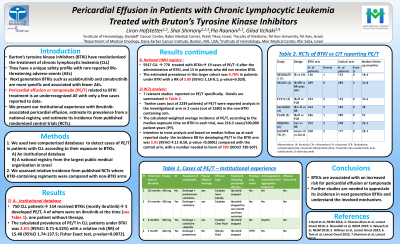Category: General Abstract
1113 - Pericardial effusion in patients with chronic lymphocytic leukemia treated with Bruton's tyrosine kinase inhibitors

Introduction: Burton tyrosine kinase inhibitor (BTKI) has revolutionized the treatment of chronic lymphocytic leukemia (CLL). While more effective than common chemoimmunotherapy (CIT) regimens, they have a unique safety profile, including rare yet reported life-threatening adverse events (AEs) such as hemorrhage, ventricular arrhythmia, and sudden death. Next-generation BTKIs such as acalabrutinib and zanubrutinib are more specific and associated with fewer AEs. Pericardial effusion or tamponade (PE/T) related to BTKI treatment is an underrecognized AE with only a few cases reported to date. Putative mechanisms may be related to on- or off-target effect of BTKI. We present our institutional experience with ibrutinib-associated pericardial effusion, estimate its prevalence from a national registry, and estimate its incidence from published randomized control trials (RCTs).
Methods: We used two computerized databases: an institutional, and a national registry from the largest public medical organization in Israel (Kupat Cholim Clalit), to detect cases of PE/T in patients with CLL according to their exposure to BTKIs. Diagnoses of pericarditis and other pericardial pathologies were excluded. We assessed the prevalence of this AE and the relative risk associated with BTKI treatment. We further assessed its relative incidence from published RCTs where BTKI-containing regiments were compared with non-BTKI, usually CIT regimens. This study was done in accordance with the institutional Helsinki Committee.
Results: At our institute, we found 4 CLL patients who developed PE/T while on treatment with ibrutinib. Details regarding the cases are listed in Table 1. All patients received full-dose of ibrutinib. Time from start of treatment to effusion development varied between 1-26 months. Three patients suffered from atrial fibrillation (AF) along with PE/T. Three patients had accompanying pleural effusion. The pericardial effusion was drained in all patients; two had bloody pericardial fluid, all had exudative markers, and cytology was negative for malignant cells in all cases. Only one patient had taken aspirin before the event. Ibrutinib was discontinued in all patients, while it was reintroduced in 1 without further events. All patients received additional treatment with prednisone and/or colchicine. PE/T did not recur in any of them.
According to our institution database, out of 750 CLL patients, 154 received BTKIs (mostly ibrutinib), 5 developed PE/T, 4 of whom were on ibrutinib at the time, and 1 was without therapy. The calculated prevalence of PE/T in CLL patients under BTKI was 2.6% (95%CI: 0.71-6.52%) with a relative risk (RR) of 15.48 (95%CI 1.74-137.5; Fisher Exact test, p-value=0.0072). In the national HMO registry of 5917 CLL patients, of whom 770 were treated with BTKIs, we identified 19 cases of PE/T: 6 after the administration of BTKI, and 13 in patients who did not receive BTKI. The estimated prevalence in this larger cohort was 0.78% in patients under BTKI with a RR of 3.09 (95%CI 1.18-8.1), p-value=0.029). Since data is anonymized, we do not have further information on these patients.
In an analysis of RCTs comparing BTKI-containing regimens with non-BTKI-containing regimens in CLL, we found 7 relevant studies that reported on PE/T specifically. Studies that reported on “other cardiac toxicity” without specifications were excluded from analysis. Details are summarized in Table 2. Twelve cases (out of 2239 patients) of PE/T were reported in the investigational arm vs 2 cases (out of 1580) in the non-BTKI containing arm. The calculated weighted average incidence of PE/T, according to the median exposure time on BTKI in each trial, was 216.2 cases/100,00 patient-years (PY). According to intention to treat analysis and based on median follow-up at each reported study, the incidence RR for developing PE/T in the BTKI arm was 5.91 (95%CI 4.11-8.50, p-value < 0.0001) compared with the control arm, with a number needed to harm of 599 (95%CI 730-507).
Conclusion: BTKIs are associated with an increased risk for pericardial effusion or tamponade. Further studies are needed to appreciate its incidence in next-generation BTKIs and understand the involved mechanism.
Methods: We used two computerized databases: an institutional, and a national registry from the largest public medical organization in Israel (Kupat Cholim Clalit), to detect cases of PE/T in patients with CLL according to their exposure to BTKIs. Diagnoses of pericarditis and other pericardial pathologies were excluded. We assessed the prevalence of this AE and the relative risk associated with BTKI treatment. We further assessed its relative incidence from published RCTs where BTKI-containing regiments were compared with non-BTKI, usually CIT regimens. This study was done in accordance with the institutional Helsinki Committee.
Results: At our institute, we found 4 CLL patients who developed PE/T while on treatment with ibrutinib. Details regarding the cases are listed in Table 1. All patients received full-dose of ibrutinib. Time from start of treatment to effusion development varied between 1-26 months. Three patients suffered from atrial fibrillation (AF) along with PE/T. Three patients had accompanying pleural effusion. The pericardial effusion was drained in all patients; two had bloody pericardial fluid, all had exudative markers, and cytology was negative for malignant cells in all cases. Only one patient had taken aspirin before the event. Ibrutinib was discontinued in all patients, while it was reintroduced in 1 without further events. All patients received additional treatment with prednisone and/or colchicine. PE/T did not recur in any of them.
According to our institution database, out of 750 CLL patients, 154 received BTKIs (mostly ibrutinib), 5 developed PE/T, 4 of whom were on ibrutinib at the time, and 1 was without therapy. The calculated prevalence of PE/T in CLL patients under BTKI was 2.6% (95%CI: 0.71-6.52%) with a relative risk (RR) of 15.48 (95%CI 1.74-137.5; Fisher Exact test, p-value=0.0072). In the national HMO registry of 5917 CLL patients, of whom 770 were treated with BTKIs, we identified 19 cases of PE/T: 6 after the administration of BTKI, and 13 in patients who did not receive BTKI. The estimated prevalence in this larger cohort was 0.78% in patients under BTKI with a RR of 3.09 (95%CI 1.18-8.1), p-value=0.029). Since data is anonymized, we do not have further information on these patients.
In an analysis of RCTs comparing BTKI-containing regimens with non-BTKI-containing regimens in CLL, we found 7 relevant studies that reported on PE/T specifically. Studies that reported on “other cardiac toxicity” without specifications were excluded from analysis. Details are summarized in Table 2. Twelve cases (out of 2239 patients) of PE/T were reported in the investigational arm vs 2 cases (out of 1580) in the non-BTKI containing arm. The calculated weighted average incidence of PE/T, according to the median exposure time on BTKI in each trial, was 216.2 cases/100,00 patient-years (PY). According to intention to treat analysis and based on median follow-up at each reported study, the incidence RR for developing PE/T in the BTKI arm was 5.91 (95%CI 4.11-8.50, p-value < 0.0001) compared with the control arm, with a number needed to harm of 599 (95%CI 730-507).
Conclusion: BTKIs are associated with an increased risk for pericardial effusion or tamponade. Further studies are needed to appreciate its incidence in next-generation BTKIs and understand the involved mechanism.
- LH
- SS
- PR
- GI
Gilad Itchaki, MD
Head, Hematology
Meir Medical Center
Kfar-Saba, HaMerkaz, Israel

